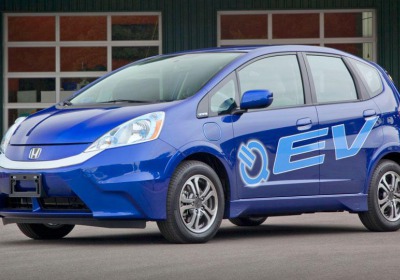2013 Honda Fit EV: Drive review
Fri, 29 Jun 2012
What is it?
The Honda Fit was already the perfect all-around people- and cargo-hauling subcompact everything car for everyone. We loved our gasoline-powered long-termer. It was lightweight, versatile and even fun to drive. So it made perfect sense for Honda to use the Fit as the basis for its first semi-mass-produced electric vehicle (anyone remember the EVPlus?). Engineers stamped a unique floorpan for the Fit EV to accommodate the 20-kilowatt-hour li-ion battery, tuned some of the aero exterior and lined the inside with spooky sounding “bio fabric.” The 92-kilowatt (123-hp) AC synchronous motor driving the front wheels can be used in three modes: eco, which maxes out at 47 kilowatts; normal, which uses 70 kilowatts; and sport, in which you get all of the 92 kilowatts you paid for.
What is it like to drive?
Right out of the parking lot we felt the car was sort of a thrill. With 100 percent of torque available at 1 rpm, electric cars will do that to you. There was no lag from launch and the feeling is probably quicker than you'd expect. But then we goofed around trying to time a 0-to-60-mph run and more or less settled on an average of 9.5 seconds in sport mode, a second or so slower in normal. So it's no Tesla Roadster. It is, in fact, slow. Still, it's kind of fun behind the wheel, more so than the Mitsubishi i and maybe about the same or slightly sportier than the Nissan Leaf. We drove both the Fit and the Leaf on an autocross course and found that they both plowed in corners but that the Leaf felt better under full-ABS braking.
The gas-powered Fit weighs 2,496 pounds while the Honda Fit EV weighs 3,252, more than 750 pounds heavier. So that will sap some performance right there, especially in such a small car. But then the Tesla Roadster feels heavier than the Lotus, too.
Honda lists an EPA range of 82 miles per charge, which is better than all of the competition. The Fit also tops all comers with 118 mpg-e, the rating used to compare mileage of a gasoline-powered car to an EV. Even the small, light Mitsubishi i gets only 112 mpg-e. Recharging the Fit is quicker, too, thanks to a 6.6-kilowatt charger where most competitors have only 3.3-kilowatts. Honda lists charge time from 240 volts at less than three hours.
In addition to adding weight you give up cargo space when you go electric. The gasoline-powered Fit offers 20.6 cubic feet of space behind the seats, 57.3 with the seats folded flat, while the Fit EV has just 12.4 and 49.4, respectively. Still, you can fit (ha!) five adults inside and most of their groceries.
Do I want it?
Honda says Fit EV owners will use their cars for commuting and running errands and will almost certainly have another car in their household. Considering that many people spend their weekdays slogging through stop-and-go traffic, a small EV such as this would be perfect for a good number of buyers.
However, Honda is offering it as a lease only--no sales. And Honda will make only 1,100 of these cars in the next two years, claiming that there is no market yet big enough to make money off any numbers greater than 600 Fit EV leases a year. To back this up, Honda cited a Global Insight projection that showed an EV market going from 26,000 in 2012 to 80,000 in 2016. But then Honda admits that no one really knows what the EV market is going to do.
Leases start on July 20 at $389 a month for 36 months, which includes maintenance (what maintenance?), collision coverage and roadside assistance. Cars will be available only in Los Angeles, San Francisco, Sacramento and Portland at first, expanding to Boston, New York, Hartford, Baltimore and Washington, D.C., in 2013.
2013 Honda Fit EV
On Lease: July 20 in limited markets
Lease Price: $389/mo
Powertrain: 92-kW AC synchronous motor, FWD
Curb Weight: 3,252 lb
0-60 MPH: 9.5 sec (AW est)
Fuel Economy (EPA): 118 mpg-e
Range (EPA): 82 mi
More information: Check out the Honda Fit at shopautoweek.com.
By Mark Vaughn

